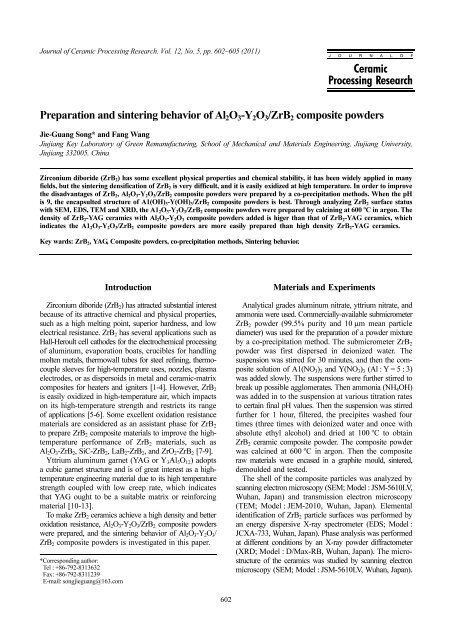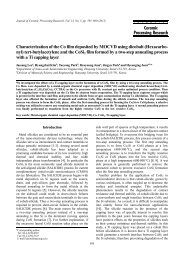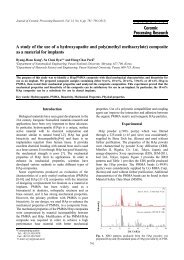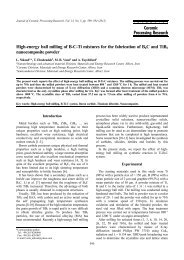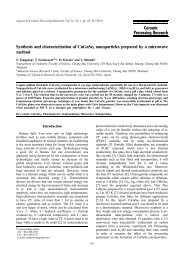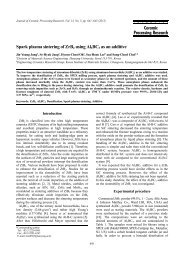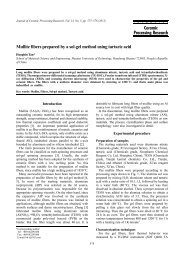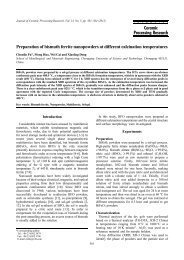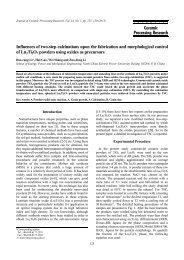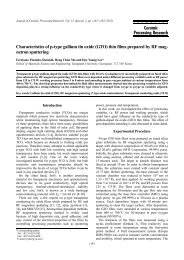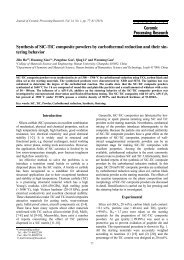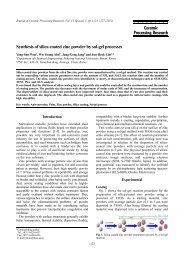Preparation and sintering behavior of Al2O3-Y2O3/ZrB2 composite ...
Preparation and sintering behavior of Al2O3-Y2O3/ZrB2 composite ...
Preparation and sintering behavior of Al2O3-Y2O3/ZrB2 composite ...
Create successful ePaper yourself
Turn your PDF publications into a flip-book with our unique Google optimized e-Paper software.
Journal <strong>of</strong> Ceramic Processing Research. Vol. 12, No. 5, pp. 602~605 (2011)<br />
J O U R N A L O F<br />
Ceramic<br />
Processing Research<br />
<strong>Preparation</strong> <strong>and</strong> <strong>sintering</strong> <strong>behavior</strong> <strong>of</strong> Al 2 O 3 -Y 2 O 3 /ZrB 2 <strong>composite</strong> powders<br />
Jie-Guang Song* <strong>and</strong> Fang Wang<br />
Jiujiang Key Laboratory <strong>of</strong> Green Remanufacturing, School <strong>of</strong> Mechanical <strong>and</strong> Materials Engineering, Jiujiang University,<br />
Jiujiang 332005, China<br />
Zirconium diboride (ZrB 2 ) has some excellent physical properties <strong>and</strong> chemical stability, it has been widely applied in many<br />
fields, but the <strong>sintering</strong> densification <strong>of</strong> ZrB 2 is very difficult, <strong>and</strong> it is easily oxidized at high temperature. In order to improve<br />
the disadvantages <strong>of</strong> ZrB 2 , Al 2 O 3 -Y 2 O 3 /ZrB 2 <strong>composite</strong> powders were prepared by a co-precipitation methods. When the pH<br />
is 9, the encapsulted structure <strong>of</strong> A1(OH) 3 -Y(OH) 3 /ZrB 2 <strong>composite</strong> powders is best. Through analyzing ZrB 2 surface status<br />
with SEM, EDS, TEM <strong>and</strong> XRD, the A1 2 O 3 -Y 2 O 3 /ZrB 2 <strong>composite</strong> powders were prepared by calcining at 600 o C in argon. The<br />
density <strong>of</strong> ZrB 2 -YAG ceramics with Al 2 O 3 -Y 2 O 3 <strong>composite</strong> powders added is higer than that <strong>of</strong> ZrB 2 -YAG ceramics, which<br />
indicates the A1 2 O 3 -Y 2 O 3 /ZrB 2 <strong>composite</strong> powders are more easily prepared than high density ZrB 2 -YAG ceramics.<br />
Key wards: ZrB 2 , YAG, Composite powders, co-precipitation methods, Sintering <strong>behavior</strong>.<br />
Introduction<br />
Zirconium diboride (ZrB 2 ) has attracted substantial interest<br />
because <strong>of</strong> its attractive chemical <strong>and</strong> physical properties,<br />
such as a high melting point, superior hardness, <strong>and</strong> low<br />
electrical resistance. ZrB 2 has several applications such as<br />
Hall-Heroult cell cathodes for the electrochemical processing<br />
<strong>of</strong> aluminum, evaporation boats, crucibles for h<strong>and</strong>ling<br />
molten metals, thermowall tubes for steel refining, thermocouple<br />
sleeves for high-temperature uses, nozzles, plasma<br />
electrodes, or as dispersoids in metal <strong>and</strong> ceramic-matrix<br />
<strong>composite</strong>s for heaters <strong>and</strong> igniters [1-4]. However, ZrB 2<br />
is easily oxidized in high-temperature air, which impacts<br />
on its high-temperature strength <strong>and</strong> restricts its range<br />
<strong>of</strong> applications [5-6]. Some excellent oxidation resistance<br />
materials are considered as an assistant phase for ZrB 2<br />
to prepare ZrB 2 <strong>composite</strong> materials to improve the hightemperature<br />
performance <strong>of</strong> ZrB 2 materials, such as<br />
Al 2 O 3 -ZrB 2 , SiC-ZrB 2 , LaB 2 -ZrB 2 , <strong>and</strong> ZrO 2 -ZrB 2 [7-9].<br />
Yttrium aluminum garnet (YAG or Y 3 Al 5 O 12 ) adopts<br />
a cubic garnet structure <strong>and</strong> is <strong>of</strong> great interest as a hightemperature<br />
engineering material due to its high temperature<br />
strength coupled with low creep rate, which indicates<br />
that YAG ought to be a suitable matrix or reinforcing<br />
material [10-13].<br />
To make ZrB 2 ceramics achieve a high density <strong>and</strong> better<br />
oxidation resistance, Al 2 O 3 -Y 2 O 3 /ZrB 2 <strong>composite</strong> powders<br />
were prepared, <strong>and</strong> the <strong>sintering</strong> <strong>behavior</strong> <strong>of</strong> Al 2 O 3 -Y 2 O 3 /<br />
ZrB 2 <strong>composite</strong> powders is investigated in this paper.<br />
*Corresponding author:<br />
Tel : +86-792-8313632<br />
Fax: +86-792-8311239<br />
E-mail: songjieguang@163.com<br />
Materials <strong>and</strong> Experiments<br />
Analytical grades aluminum nitrate, yttrium nitrate, <strong>and</strong><br />
ammonia were used. Commercially-available submicrometer<br />
ZrB 2 powder (99.5% purity <strong>and</strong> 10 µm mean particle<br />
diameter) was used for the preparation <strong>of</strong> a powder mixture<br />
by a co-precipitation method. The submicrometer ZrB 2<br />
powder was first dispersed in deionized water. The<br />
suspension was stirred for 30 minutes, <strong>and</strong> then the <strong>composite</strong><br />
solution <strong>of</strong> A1(NO 3 ) 3 <strong>and</strong> Y(NO 3 ) 3 (Al:Y=5:3)<br />
was added slowly. The suspensions were further stirred to<br />
break up possible agglomerates. Then ammonia (NH 4 OH)<br />
was added in to the suspension at various titration rates<br />
to certain final pH values. Then the suspension was stirred<br />
further for 1 hour, filtered, the precipites washed four<br />
times (three times with deionized water <strong>and</strong> once with<br />
absolute ethyl alcohol) <strong>and</strong> dried at 100 o C to obtain<br />
ZrB 2 ceramic <strong>composite</strong> powder. The <strong>composite</strong> powder<br />
was calcined at 600 o C in argon. Then the <strong>composite</strong><br />
raw materials were encased in a graphite mould, sintered,<br />
demoulded <strong>and</strong> tested.<br />
The shell <strong>of</strong> the <strong>composite</strong> particles was analyzed by<br />
scanning electron microscopy (SEM; Model : JSM-5610LV,<br />
Wuhan, Japan) <strong>and</strong> transmission electron microscopy<br />
(TEM; Model : JEM-2010, Wuhan, Japan). Elemental<br />
identification <strong>of</strong> ZrB 2 particle surfaces was performed by<br />
an energy dispersive X-ray spectrometer (EDS; Model :<br />
JCXA-733, Wuhan, Japan). Phase analysis was performed<br />
at different conditions by an X-ray powder diffractometer<br />
(XRD; Model : D/Max-RB, Wuhan, Japan). The microstructure<br />
<strong>of</strong> the ceramics was studied by scanning electron<br />
microscopy (SEM; Model : JSM-5610LV, Wuhan, Japan).<br />
602
<strong>Preparation</strong> <strong>and</strong> <strong>sintering</strong> <strong>behavior</strong> <strong>of</strong> Al 2 O 3 -Y 2 O 3 /ZrB 2 <strong>composite</strong> powders 603<br />
Results <strong>and</strong> Discussion<br />
Influence <strong>of</strong> pH on the microstructure <strong>of</strong> Al(OH) 3 -<br />
Y(OH) 3 /ZrB 2 <strong>composite</strong> powders<br />
Al(OH) 3 -Y(OH) 3 /ZrB 2 <strong>composite</strong> powders was synthesized<br />
at particular value <strong>of</strong> the pH. The configuration<br />
<strong>of</strong> an original <strong>and</strong> coated ZrB 2 surface is compared in<br />
Fig. 1. A smooth surface is presented on the original ZrB 2<br />
particles. The ZrB 2 surface is coated with a few floccules<br />
<strong>of</strong> Al(OH) 3 precipitate at pH = 7. Because the pH satisfies<br />
the production <strong>of</strong> the Al(OH) 3 precipitates from the<br />
Al(NO 3 ) 3 solution via heterogeneous nucleation, the Al 3+<br />
does not form Al(OH) 3 precipitates completely. However,<br />
a layer <strong>of</strong> symmetrical floccules with Al(OH) 3 <strong>and</strong> Y(OH) 3<br />
precipitates is coated on the ZrB 2 surface at pH = 9,<br />
which is about 150 nm thick. The thickness <strong>of</strong> the coating<br />
layer is decreased at pH = 11. Many small spheroidal masses<br />
remain with the Y(OH) 3 precipitates on the ZrB 2 surfaces.<br />
With an increase in the pH <strong>of</strong> the ZrB 2 suspension, the<br />
entire process from Al(NO 3 ) 3 <strong>and</strong> Y(NO 3 ) 3 solution to<br />
Al(OH) 3 <strong>and</strong> Y(OH) 3 precipitate is shown in four steps: no<br />
deposit, heterogeneous nucleation, homogeneous nucleation,<br />
<strong>and</strong> a complete deposit [14]. The relationship <strong>of</strong> the<br />
Al 3+ complex <strong>and</strong> pH is shown in Fig. 2. After the complete<br />
deposition process, Al(OH) 3 is formed as an AlO 2 soluble<br />
complex in the suspension <strong>of</strong> ZrB 2 by a continuous<br />
increase <strong>of</strong> the pH [15]. However, Y(OH) 3 precipitates do<br />
not dissolve in the alkaline solution, which still exist on<br />
the ZrB 2 surface. When the pH is 9, Al(OH) 3 -Y(OH) 3 /ZrB 2<br />
<strong>composite</strong> powders with a better coating quality are formed.<br />
Charactorization <strong>of</strong> Al 2 O 3 -Y 2 O 3 /ZrB 2 <strong>composite</strong><br />
powders<br />
Phase analysis <strong>of</strong> ZrB 2 particles is shown in Fig. 3, which<br />
Fig. 1. Topographic characteristics <strong>of</strong> A1(OH) 3 -Y(OH) 3 /ZrB 2<br />
<strong>composite</strong> powders under different pH conditions (a-Original, b-<br />
pH = 7, c- pH = 9 <strong>and</strong> d- pH = 11).<br />
Fig. 2. Relation <strong>of</strong> Al compounds <strong>and</strong> pH.<br />
Fig. 3. XRD <strong>of</strong> ZrB 2 after treating under different conditons (a-<br />
Original ZrB 2 , b-Coated ZrB 2 with A1(OH) 3 -Y(OH) 3 <strong>and</strong> c-Coated<br />
ZrB 2 with Al 2 O 3 -Y 2 O 3 ).<br />
indicates the main phase is the ZrB 2 phase, but a different<br />
phase is found as the conditions are changed. The<br />
backgrounds <strong>of</strong> Fig. 3(b) <strong>and</strong> (c) are higher than for<br />
Fig. 3(a). Because ZrB 2 particles are coated with amorphous<br />
A1(OH) 3 <strong>and</strong> Y(OH) 3 precipitate, Fig. 3(c) shows the<br />
Al 2 O 3 <strong>and</strong> Y 2 O 3 phases, because A1(OH) 3 <strong>and</strong> Y(OH) 3<br />
were dehydrated.<br />
Elemental identification <strong>and</strong> the shell configuration<br />
<strong>of</strong> ZrB 2 particle surfaces under different conditions are<br />
shown in Fig. 4. The original ZrB 2 particles only show<br />
Zr <strong>and</strong> B, but the surface <strong>of</strong> coated ZrB 2 particles shows<br />
Al <strong>and</strong> Y in addition to Zr <strong>and</strong> B. A1(NO 3 ) 3 <strong>and</strong> Y(NO 3 ) 3<br />
have formed A1(OH) 3 <strong>and</strong> Y(OH) 3 precipitates at pH = 9<br />
coated on the surface <strong>of</strong> ZrB 2 particles through the coprecipitation.<br />
The surface <strong>of</strong> the original ZrB 2 particles<br />
is very smooth (Fig. 4(a)). Coated ZrB 2 particles (dried<br />
at 100 o C) are shown in Fig. 4(b); the surface <strong>of</strong> ZrB 2<br />
particles is coated with a layer <strong>of</strong> floccules <strong>of</strong> A1(OH) 3<br />
<strong>and</strong> Y(OH) 3 precipitates. Coated ZrB 2 particles (calcined<br />
at 600 o C) are shown in Fig. 4(c); the surfaces <strong>of</strong> ZrB 2<br />
particles are not smooth <strong>and</strong> many fine particles are evident.<br />
Fig. 3(c) is the phase analysis <strong>of</strong> <strong>composite</strong> particles<br />
calcined at 600 o C, <strong>and</strong> the background <strong>of</strong> the phase<br />
picture is high, which means the <strong>composite</strong> particles<br />
contain A1(OH) 3 <strong>and</strong> Y(OH) 3 .
604 Jie-Guang Song <strong>and</strong> Fang Wang<br />
Fig. 4. SEM <strong>and</strong> EDS <strong>of</strong> ZrB 2 after treating under different conditons<br />
(a-Original ZrB 2 , b-Coated ZrB 2 with A1(OH) 3 -Y(OH) 3 <strong>and</strong> c-<br />
Coated ZrB 2 with Al 2 O 3 -Y 2 O 3 ).<br />
Fig. 5. TEM <strong>of</strong> ZrB 2 after treating under different conditons (a<br />
<strong>and</strong> b-Original ZrB 2 , c <strong>and</strong> d- Coated ZrB 2 with A1(OH) 3 -Y(OH) 3 ,<br />
e <strong>and</strong> f- Coated ZrB 2 with Al 2 O 3 -Y 2 O 3 after being calcined at 600 o C).<br />
TEM <strong>of</strong> ZrB 2 particles under different conditions are<br />
shown in Fig. 5. The surface <strong>of</strong> the original ZrB 2 particles<br />
is very smooth (Figs. 5(a) <strong>and</strong> (b)). TEM <strong>of</strong> coated ZrB 2<br />
particles (dried at 100 o C) is shown in Figs. 5(c) <strong>and</strong><br />
(d), the surface <strong>of</strong> ZrB 2 particles is coated with a layer<br />
<strong>of</strong> floccule fine pricipitates about 30 nm in size, which<br />
is uniform <strong>and</strong> compact. TEM <strong>of</strong> coated ZrB 2 particles<br />
(calcined at 600 o C) is shown in Figs. 5(e) <strong>and</strong> (f); the surface<br />
<strong>of</strong> ZrB 2 particles is coated with Al 2 O 3 -Y 2 O 3 nanoparticles<br />
to form A1 2 O 3 -Y 2 O 3 /ZrB 2 <strong>composite</strong> powders; the Al 2 O 3 -<br />
Y 2 O 3 shell is about 30 nm thick, which is uniform.<br />
A1 2 O 3 -Y 2 O 3 /ZrB 2 <strong>composite</strong> powders were successfully<br />
synthesized as shown by their characterization.<br />
Sintering <strong>behavior</strong> <strong>of</strong> Al 2 O 3 -Y 2 O 3 /ZrB 2 <strong>composite</strong><br />
powders<br />
The <strong>sintering</strong> curve for preparing ZrB 2 -20 wt%YAG<br />
multiphase ceramic materials from different <strong>composite</strong><br />
raw materials with the spark plasma <strong>sintering</strong> techniqe<br />
is shown in Fig. 6. The spark plasma <strong>sintering</strong> Z-axis<br />
displacement shows the shrinkage state <strong>of</strong> a ceramic body<br />
during the <strong>sintering</strong> process, when the value <strong>of</strong> the Z-axis<br />
displacement increases, this indicates the ceramic body<br />
is shrinking. The Z-axis displacement shows the shrinkage<br />
Fig. 6. Sintering shrinkage curve <strong>of</strong> ZrB 2 -20 wt%YAG ceramics.<br />
state <strong>of</strong> adding Al 2 O 3 -Y 2 O 3 <strong>composite</strong> powders <strong>and</strong> YAG<br />
powders, respectively. The <strong>composite</strong> powders with<br />
Al 2 O 3 -Y 2 O 3 added show a rapid shrinkage displacement<br />
from 700 o C to 950 o C, where the biggish shrinkage<br />
displacement also is shown from 950 o C to 1600 o C, the<br />
Z-axis displacement is not varied basically above 1600 o C.<br />
The <strong>sintering</strong> temperature curve is broken down into four<br />
parts, which include a preheating process below 700 o C,<br />
a reaction process from 700 o C to 950 o C, a <strong>sintering</strong><br />
process from 950 o C to 1600 o C, <strong>and</strong> an adjustment <strong>of</strong> the<br />
microstructure above 1600 o C. The densification occurs<br />
mainly during the reaction process <strong>and</strong> <strong>sintering</strong> process,
<strong>Preparation</strong> <strong>and</strong> <strong>sintering</strong> <strong>behavior</strong> <strong>of</strong> Al 2 O 3 -Y 2 O 3 /ZrB 2 <strong>composite</strong> powders 605<br />
ceramics with Al 2 O 3 -Y 2 O 3 <strong>composite</strong> powder added is<br />
higer than that <strong>of</strong> ZrB 2 -YAG ceramics with YAG powder<br />
added, which indicates the A1 2 O 3 -Y 2 O 3 /ZrB 2 <strong>composite</strong><br />
powders are more easily prepared <strong>and</strong> have a higher<br />
density than ZrB 2 -YAG ceramics.<br />
Acknowledgments<br />
Fig. 7. SEM <strong>of</strong> ZrB 2 -20 wt%YAG ceramics (a-Coated ZrB 2 with<br />
Al 2 O 3 -Y 2 O 3 , b-Mixed ZrB 2 with YAG).<br />
that is, <strong>sintering</strong> from 700 o C to 1600 o C. YAG is produced<br />
from 700 o C to 950 o C. The reaction temperature is lower<br />
than the 1100 o C for synthesizing YAG powders from<br />
Al 2 O 3 -Y 2 O 3 <strong>composite</strong> powders, because ZrB 2 particles<br />
are changed electrically during the entire <strong>sintering</strong> process,<br />
which produces a plasma among ZrB 2 particles to purify<br />
the nearby particle surfaces <strong>and</strong> increase the <strong>sintering</strong><br />
activity [16-18].<br />
However, the Z-axis displacement for powders with<br />
YAG added shows a lower shrinkage displacement below<br />
950 o C; a larger shrinkage displacement is shown from<br />
950 o C to 1600 o C, the Z-axis displacement is not varied<br />
basically above 1700 o C. The Z-axis displacement adding<br />
the different powders both show the same shrinkage<br />
state from 950 o C to 1600 o C, YAG melts above 950 o C,<br />
the temperature is lowered because <strong>of</strong> the action <strong>of</strong> the<br />
plasma. Because the results <strong>of</strong> the two routes both show<br />
the Z-axis displacement is not varied basically above<br />
1700 o C, a <strong>sintering</strong> temperature <strong>of</strong> 1700 o C is choosen<br />
for preparing high density ZrB 2 -YAG multiphase ceramics,<br />
the microstructure <strong>of</strong> ZrB 2 -YAG multiphase ceramics<br />
are shown in Fig. 7, which indicates the density <strong>of</strong> ZrB 2 -<br />
YAG ceramics with Al 2 O 3 -Y 2 O 3 <strong>composite</strong> powder added<br />
is higer than that <strong>of</strong> ZrB 2 -YAG ceramics with YAG<br />
powder added.<br />
Conclusions<br />
Al 2 O 3 -Y 2 O 3 /ZrB 2 <strong>composite</strong> powders were prepared<br />
by a co-precipitation methods. When the pH is 9, the<br />
encapsulted structure <strong>of</strong> A1(OH) 3 -Y(OH) 3 /ZrB 2 <strong>composite</strong><br />
powders is the best. By analyzing the ZrB 2 surface status<br />
with SEM, EDS, TEM <strong>and</strong> XRD, the A1 2 O 3 -Y 2 O 3 /ZrB 2<br />
<strong>composite</strong> powders were prepared under the calcining<br />
conditions <strong>of</strong> 600 o C in argon. The density <strong>of</strong> ZrB 2 -YAG<br />
The authors are thankful for the financial support provide<br />
by the Science <strong>and</strong> Technology Support Fund for Young<br />
Scholars <strong>of</strong> the Educational Department <strong>of</strong> Jiangxi Province,<br />
China (Grant No.GJJ09595), <strong>and</strong> for the apparatus provided<br />
by The Center for Materials Testing <strong>and</strong> The Functionally<br />
Gradient Material (FGM) Research Laboratory <strong>of</strong> Wuhan<br />
University <strong>of</strong> Technology, China.<br />
References<br />
1. L. Silvestroni, D. Sciti, C. Mel<strong>and</strong>ri <strong>and</strong> S. Guicciardi, J.<br />
Eur. Ceram. Soc. 30 (2010) 2155-2164.<br />
2. S.M. Zhu, W.G. Fahrenholtz, G.E. Hilmas <strong>and</strong> S.C. Zhang,<br />
Mater. Sci. Eng. A 459 (2007) 167-17.<br />
3. J.G. Song, G.C. Ji <strong>and</strong> S.B. Li, J. Ceram. Process. Res. 10<br />
(2009) 428-432.<br />
4. P. Hu, X.H. Zhang <strong>and</strong> J.C. Han, J. Am. Ceram. Soc., 93<br />
(2010) 345-349.<br />
5. I.B. Bankovskaya, M.P. Semov <strong>and</strong> A.E. Lapshin, Glass<br />
Phys. Chem., 31 (2005) 433-438.<br />
6. A.L. Chamberlain, W.G. Fahrenholtz <strong>and</strong> G.E. Hilmas, J.<br />
Am. Ceram. Soc., 89 (2006) 450-456.<br />
7. J.G. Song, D.M. Du <strong>and</strong> Y.Y. Ju, J. Ceram. Process. Res.,<br />
11 (2010) 494-497.<br />
8. A. Bellosi, F. Monteverde <strong>and</strong> D. Sciti, Int. J. Appl. Ceram.<br />
Tec., 3 (2006) 32-40.<br />
9. H.F. Hu, Q.K. Wang <strong>and</strong> Z.H. Chen, Ceram. Int., 36<br />
(2010) 1011-1016.<br />
10. X.X. Li <strong>and</strong> W.J. Wang, Powder Technol., 196 (2009) 26-29.<br />
11. S.J. Wang, Y.B. Xua, P.X. Lua, C.F. Xu <strong>and</strong> W. Cao, Mater.<br />
Sci. Eng. B, 127 (2006) 203-206.<br />
12. Y.M. Zhang <strong>and</strong> H.M. Yu, Ceram. Int., 35 (2009) 2077-2081.<br />
[13] J. G. Song, Mater. Manuf. Process., 25 (2010) 724-729.<br />
14. R. Vallepu, A.M. Jimenez, T. Terai <strong>and</strong> A. Mikuni, J.<br />
Ceram. Soc. Jap., 114 (2006) 624-629.<br />
15. A.V. Radha <strong>and</strong> P.V. Kamath, Bull. Mater. Scie., 26 (2003)<br />
661-666.<br />
16. N. Frage, S. Kalabukhov <strong>and</strong> N. Sverdlov, J. Eur. Ceram.<br />
Soc., 30 (2010) 3331-3337.<br />
17. J.G. Song, D.M. Du <strong>and</strong> Y.Y. Ju, J. Reinf. Plast. Comp., 29<br />
(2010) 710-717.<br />
18. Y.H. Sang, H. Liu <strong>and</strong> Y.H. Lv, J. Alloy. Compd., 490<br />
(2010) 459-462.


